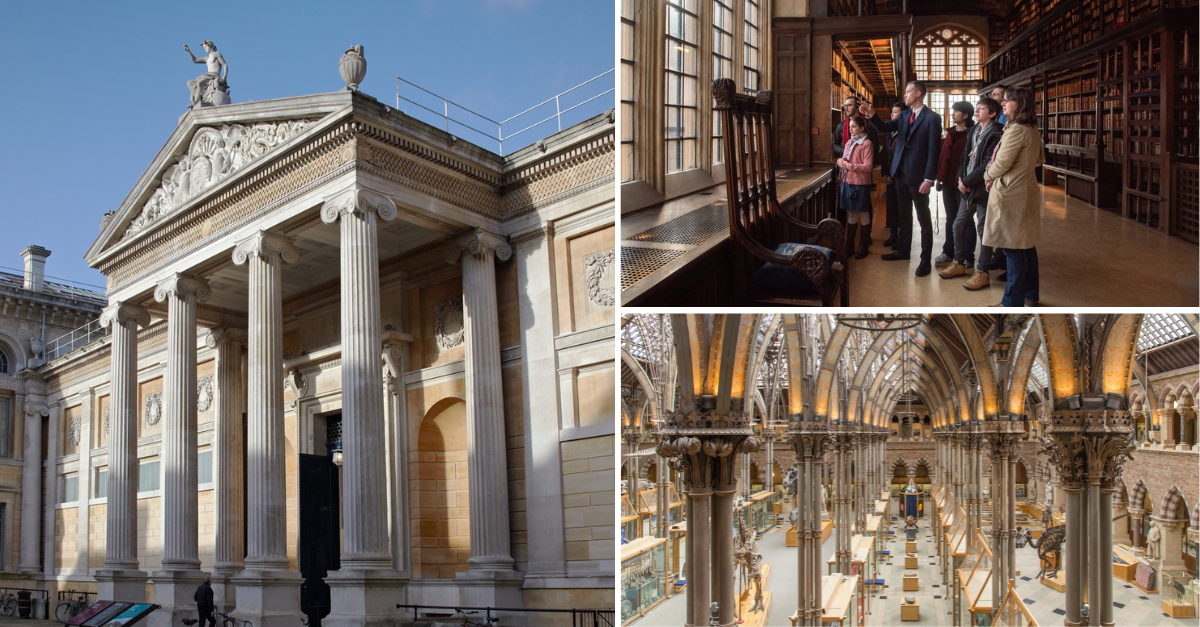Visits to Oxford University attractions up 20% in 2023 – University’s Gardens, Libraries and Museums welcome 3.2 million visitors in 2023

Oxford University Gardens, Libraries and Museums experienced a large increase in visitors in 2023, according to figures released today by the Association of Leading Visitor Attractions (ALVA).
Oxford University Gardens, Libraries and Museums welcomed over 3.2 million visitors (3,322,028) in 2023 compared to 2.7 million (2,764,766) visitors in 2022. This is a 20% increase from the previous year and just above the average increase of 19% across all ALVA attractions.
Oxford University Gardens, Libraries and Museums (GLAM) are comprised of four museums (the Ashmolean Museum, History of Science Museum, Pitt Rivers Museum and the Museum of Natural History), the Oxford Botanic Garden and Arboretum and the Bodleian Libraries.
Three University sites appeared in ALVA’s list of the UK’s top 50 attractions of 2024. The Ashmolean Museum ranked 34th most visited attraction in the UK; the Bodleian Libraries ranked 39th; and the Oxford University Museum of Natural History ranked 47th. Out of 349 visitor attractions the Pitt Rivers Museum came in at 102nd, Oxford Botanic Garden and Arboretum was 164th and the History of Science Museum was 176th.
Three sites saw a particularly big jump in visitors:
• The Ashmolean Museum saw a 24% increase in visitors, from 728,951 in 2022 to 900,277 in 2023. This makes the Ashmolean the most visited attraction in Oxfordshire after Blenheim Palace.
• Pitt Rivers Museum saw a 27% increase in visitors in 2023, putting them just outside the top 100 attractions in the UK.
• The History of Science Museum saw an impressive 53% increase in visitors, from 128,234 in 2022 to 195,643 in 2023.
There’s lots happening across the Gardens, Libraries and Museums in 2024. The Ashmolean Museum’s latest exhibition, Bruegel to Rubens: Great Flemish Masters opens on 23 March and has already generated media interest. The Weston Library has just launched the exhibition Write, Cut, Rewrite, dedicated to the creative importance of editing in literature. Pitt Rivers Museum’s newest displays, Na Mele o Hula Kahiko and Mo’olelo of the Ahupua’a celebrate Hawaiian culture. Oxford Botanic Garden has a busy program of events and tours throughout the spring while Harcourt Arboretum will be running its very popular Spring Fair on 27 April.
This year the History of Science Museum is celebrating its 100th anniversary and Pitt Rivers Museum celebrates its 140th. The Museum of Natural History is celebrating 200 years since Oxford’s Megalosaurus became the first named dinosaur. The Gardens, Libraries and Museums will also be running events and activities as part of OxfordKafka24, the University-wide celebration of the literary works and enduring global legacy of Franz Kafka, marking the centenary of the author’s untimely death.
Richard Ovenden, Bodley’s Librarian and Head of the Gardens, Libraries and Museums, says: ‘It’s wonderful to see the latest ALVA figures, showing how Oxford’s amazing Gardens, Libraries and Museums share the University’s research, history and outstanding collections with so many people – both Oxford residents and visitors from across the globe. It’s a testament to the skill and dedication of our teams across our cultural and scientific collections.’
– ENDS –
Further information
Sarah Holland, Press Assistant
Oxford University Gardens, Libraries & Museums
Sarah.Holland@glam.ox.ac.uk
Notes to editors:
• The University of Oxford’s Gardens, Libraries and Museums consist of the Botanic Garden and Arboretum, the Ashmolean Museum, the History of Science Museum, the Museum of Natural History, the Pitt Rivers Museum, and the Bodleian Libraries.
• The four University museums are home to over 8.5 million objects representing the natural world, global art and artefacts: the Ashmolean is the first public museum in Britain and its collections include the most important group of Raphael drawings in the world; the Museum of the History of Science – housed in the world’s oldest surviving purpose-built museum building – contains the world’s finest collection of historic scientific instruments; the Museum of Natural History houses 4.5m zoological, entomological and palaeontological specimens, including the fossil bones of the first dinosaur ever to be described scientifically; the Pitt Rivers holds one of the world’s finest collections of anthropology and archaeology, with objects from every continent and from throughout human history. The Bodleian is one of the oldest libraries in Europe and, with over 13 million printed items, is second only in size to the British Library in Britain. The Harcourt Arboretum – a 130-acre site close to Oxford – contains some of the oldest redwoods in the UK and one of the best bluebell woods in Oxfordshire.
• As the first botanic garden in the UK (founded in 1621), at the UK’s oldest University, Oxford Botanic Garden occupies a world-class position in terms of its history and academic location. The Arboretum (acquired by the University in 1947 and frequently called Harcourt Arboretum), a 15 minute drive from Oxford at Nuneham Courtney, contains some of the finest conifer collections in the UK set within 130 acres of historic, picturesque landscape. Together, the Garden and Arboretum are an incredible resource for research, education, conservation and inspiration for a new generation of botanists.
A range of high-resolution images can be downloaded here.



